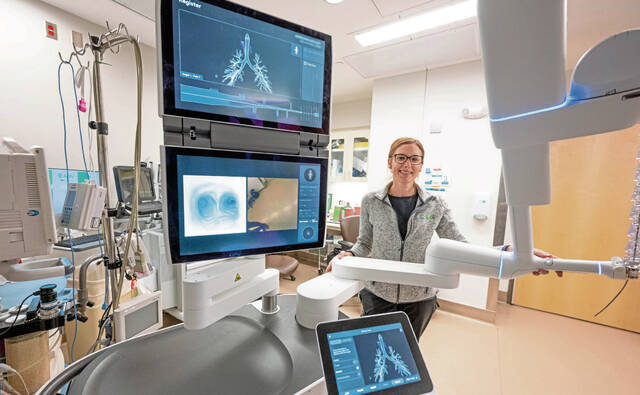The Pennsylvania Game Commission could soon be using specially trained dogs to help sniff out deer infected with chronic wasting disease as part of a new effort to learn more about the fatal, contagious ailment that continues to spread among the state’s herd.
Studies from the University of Pennsylvania’s Penn Vet’s Working Dog Center found that dogs can determine if a deer or elk has CWD by sniffing the animal’s scat. The dogs will be tested in the field to find out if they can detect the remnants of the disease in the wild.
“We’re looking forward to assessing the results of these ongoing research programs,” said Lisa Murphy, co-director of Penn Vet’s Wildlife Futures Program.
It is one of the plans supported by the game commission to learn more about and combat the disease.
Another project will look at the impact of chronic wasting disease on deer in Bedford and Fulton counties, which have produced about 90% of known positive cases since the disease’s discovery in Pennsylvania in 2012.
The game commission will collaborate with the Cooperative Fish and Wildlife Research Unit at Penn State University and the University of Pennsylvania School of Veterinary Medicine’s Wildlife Futures Program to capture and outfit deer with GPS collars to monitor their health and life spans.
“Although it is unfortunate that CWD is now found in about one of every five hunter-harvested adult deer in these counties, these circumstances do provide a higher probability of capturing, marking and monitoring individual CWD-infected deer,” said Andrea Korman, the game commission’s CWD supervisor. “It will give us insight into the effects of CWD on Pennsylvania’s deer population.”
Another project with the Cooperative Fish and Wildlife Research Unit will include modeling to investigate how the disease could affect future deer populations and possible actions to reduce negative effects. The ultimate impact of chronic wasting disease on Pennsylvania’s deer herd is unknown.
“Pennsylvania’s landscape is ideal for whitetailed deer, so it is important for the game commission to have Pennsylvania-specific data when recommending CWD management actions,” said David Walter, assistant leader of the Pennsylvania Cooperative Fish and Wildlife Research Unit.
What area hunters think
Hunters in Pennsylvania familiar with the disease are concerned about its increased spread over the years.
“Each year, we watch the (disease management area) grow, and seeing how it has spread, it wouldn’t be crazy to think that it will have spread across the state in a few years,” said Klint Macro, president of the Allegheny County Sportsmen’s League. “Ultimately, I think it affects the herd, and, when the herd is affected, it damages the species and the ecosystem. So it will definitely affect the sport and tradition of hunting.”
Hunters who harvest deer in disease management areas must leave behind high-risk carcass parts for the game commission to test for CWD. Hunters receive the test results and can choose to eat or discard the meat.
“Just because a deer is harvested in a (disease management area) doesn’t mean that it has CWD,” Macro said. “Some choose to eat it either way, and some throw it out if it’s a positive test.”
According to the game commission, there is no evidence of CWD infecting humans or other species under natural conditions, but a lot is still unknown about CWD. Given the uncertainty, the commission says limiting exposure of wildlife, livestock and people to CWD is essential.
“It’s really discouraging to hunt in a CWD area because the commission advises against eating the meat if the deer tests positive, so it feels like we did all of that work for nothing,” said Mike Bilik, vice president of the Westmoreland County Sportsmen’s League.
Bilik said CWD always will be in nature, and people should be more conscientious about mitigating its spread. He recommended people stop feeding deer corn, especially where CWD has been found.
The Allegheny County Sportsmen’s League has been working to collect funds to put toward research on CWD. The goal is to find a cure to preserve the deer population, Macro said.
“Whether you’re a hunter or not, everyone is proud of our whitetail deer,” Macro said.
Detection is a challenge
Detection is particularly challenging because of the disease’s long incubation period, according to the game commission. Infected animals might not show clinical signs of the disease for up to 18 to 24 months after infection. While still being asymptomatic, they continue spreading the disease.
There is no approved live-animal test for CWD. Current testing methods detect the disease by examining tissues collected from dead animals.
Chronic wasting disease is similar to scrapie in sheep, “mad cow disease” in cattle and Creutzfeldt-Jakob disease in humans, according to the game commission. There is no natural immunity to the disease, and there is no cure. The disease spreads through direct animal-to-animal contact, as well as indirectly through prion-contaminated environments.
Macro said the best thing to do to combat CWD is to become educated about it and help others become familiar with it. If a deer is acting odd, not reacting to surrounding stimulus or looks “mangy,” report the sighting to the game commission.








